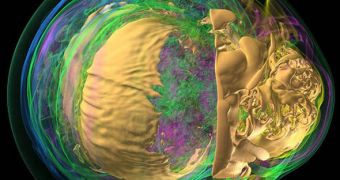Experts at the US Department of Energy's (DOE) Argonne National Laboratory (ANL) have recently taken another step in helping us understand the complex nature of our Universe, when they created the first high-complexity simulation of a supernova, the explosion that occurs when a massive star dies and collapses. The image is so complex, that it would take more than three years for an average computer user to just download the data the scientists used for the job. Its goal is to provide experts with new means of understanding the supernovae, without actually having to wait for one to happen.
“On the scale that we're working, creating a movie would take a very long time on your laptop – just rotating the image one degree could take days,” ANL expert Mark Hereld, who is in charge of the facility's visualization and analysis efforts, explains. The team uses advanced supercomputers for the job, as these machines have the ability to process quadrillions of data points in a single second. At this point, they provide the only alternative solution to actually pointing telescopes at the skies, and waiting for tens of thousands of years for supernovae to occur in nature, Space reports.
One of the major innovations the new simulation brought forth was the fact that the scientists did not send the data put together by ANL's 160,000-processor computer to a batch of graphics processors (GPU). The latter are all designed by the video game industry, and, as such, do not handle science data very well. Rather, Hereld says, the images were processed on the spot, inside the supercomputer. According to the results, this move significantly increased the efficiency of the operation.
ANL postdoctoral researcher Tom Peterka adds that, “We were able to scale up to large problem sizes of over 80 billion voxels per time step and generated images up to 16 megapixels. In astrophysics, studying how stars burn and explode pulls together all kinds of physics: hydrodynamics, gravitational physics, nuclear chemistry and energy transport. Other models study the migration of dangerous pollutants through complex structures in the soil, to see where they're likely to end up; or combustion in cars and manufacturing plants – where fuel is consumed and whether it's efficient.”
“Those kinds of problems often lead to questions that are very complicated to pose mathematically. But when you can simply watch a star explode through visualization of the simulation, you can gain insight that's not available any other way,” Hereld concludes.

 14 DAY TRIAL //
14 DAY TRIAL //